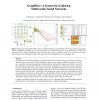710 search results - page 64 / 142 » An Architecture for Exploring Large Design Spaces |
CN
2007
14 years 12 months ago
2007
Worms are self-replicating malicious programs that represent a major security threat for the Internet, as they can infect and damage a large number of vulnerable hosts at timescal...
108
click to vote
CE
2004
14 years 11 months ago
2004
Much computer-based learning is largely passive, based primarily on task-based, exercise-driven interactions. We argue that computers have greater potential for promoting more act...
112
Voted
CGF
2010
15 years 12 hour ago
2010
Social networks collected by historians or sociologists typically have a large number of actors and edge attributes. Applying social network analysis (SNA) algorithms to these net...
102
click to vote
IPPS
2006
IEEE
15 years 6 months ago
2006
IEEE
Performance and workload modeling has numerous uses at every stage of the high-end computing lifecycle: design, integration, procurement, installation and tuning. Despite the trem...
115
click to vote
SIGOPSE
2004
ACM
15 years 5 months ago
2004
ACM
Web application workloads are often characterized by a large number of unique read requests and a significant fraction of write requests. Hosting these applications drives the ne...

